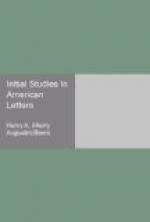Henry Wadsworth Longfellow (1807-82), the most widely read and loved of American poets—or, indeed, of all contemporary poets in England and America—though identified with Cambridge for nearly fifty years, was a native of Portland, Maine, and a graduate of Bowdoin College, in the same class with Hawthorne. Since leaving college, in 1825, he had studied and traveled for some years in Europe, and had held the professorship of modern languages at Bowdoin. He had published several text-books, a number of articles on the Romance languages and literatures in the North American Review, a thin volume of metrical translations from the Spanish, a few original poems in various periodicals, and the pleasant sketches of European travel entitled Outre-Mer. But Longfellow’s fame began with the appearance in 1839 of his Voices of the Night. Excepting an earlier collection by Bryant this was the first volume of real poetry published in New England, and it had more warmth and sweetness, a greater richness and variety, than Bryant’s work ever possessed. Longfellow’s genius was almost feminine in its flexibility and its sympathetic quality. It readily took the color of its surroundings and opened itself eagerly to impressions of the beautiful from every quarter, but especially from books. This first volume contained a few things written during his student days at Bowdoin, one of which, a blank-verse piece on Autumn, clearly shows the influence of Bryant’s Thanatopsis. Most of these juvenilia had nature for their theme, but they were not so sternly true to the New England landscape as Thoreau or Bryant. The skylark and the ivy appear among their scenic properties, and in the best of them, Woods in Winter, it is the English “hawthorn” and not any American tree, through which the gale is made to blow, just as later Longfellow uses “rooks” instead of crows. The young poet’s fancy was instinctively putting out feelers toward the storied lands of the Old World, and in his Hymn of the Moravian Nuns of Bethlehem he transformed the rude church of the Moravian sisters to a cathedral with “glimmering tapers,” swinging censers, chancel, altar, cowls, and “dim mysterious aisle.” After his visit to Europe Longfellow returned deeply imbued with the spirit of romance. It was his mission to refine our




